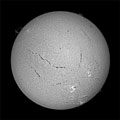
The observations shown here are made with a Coronado "Personal Solar Telescope" (PST). The off-band images have the filter tuned off the H-alpha line as far as possible to the blue (~0.2 nm). The on-band images are made with the addition of the SM40 etalon. The product of the PST and SM40 results in a sharper and narrower bandpass, giving a higher contrast view of features on the disk. A schematic view of the bandpass is shown in the figure. This gives estimates of the PST and SM40 bandpasses and their product - superimposed on the McMath FTS solar spectral atlas (see: http://see.msfc.nasa.gov/tte/db_atlases.htm).
The images are recorded with a Sony DSC F-717 five megapixel digital camera coupled to the telescope with a DigimaxT 40 eyepiece. The major problem in using a standard colour digital camera with a monchromatic source like H-alpha is that the camera only sees the image in its 'red' pixels, ie, one out of every four (normally, these cameras have two green and one blue for every red pixel). This means that an individual exposure has poor resolution and suffers from the pixel interpolation artifacts arising from the algorithm used in constructing a 3-colour image from the sets of four pixels.
This problem can be alleviated by averaging or 'stacking' many similar images. I usually take between 9 and 30 images, align them with one another and then stack them. With Mac OS X, I use a shareware program called "Keith's Image Stacker" written by Keith Wiley. The resulting average can then be further processed and 'colourised' in a program like Photoshop.
I have found it best when using the Sony camera to expose frames in the "Night Shot" mode. This works without the infrared blocking filter necessary for normal colour pictures and allows some H-alpha light to be detected through the filter red-leaks in the green and blue pixels. At least, I think this is what happens - but it is hard to tell since the Night Shot processing algorithm seems to distribute signal almost equally amongst the red, green and blue channels.
Typical individual exposures are 1/30 sec at ASA 250 for the on-band and a little faster for the off-band. These arise from setting the auto-exposure to +0.7EV.
Most of the pictures are taken with an altaz mount: this means that the images are aligned neither exactly NS nor along the Solar rotation axis. I flip them to be approximately North at the top and East to the left: but they are taken with the camera vertical at the local time/place.